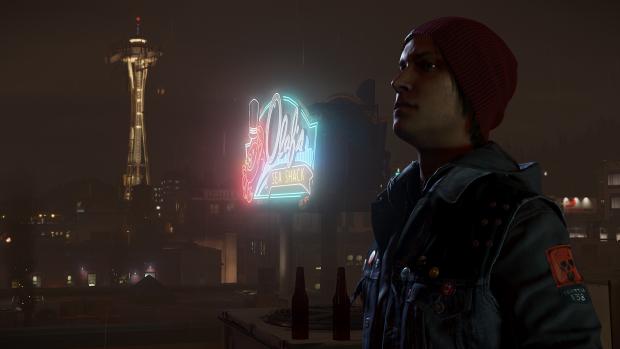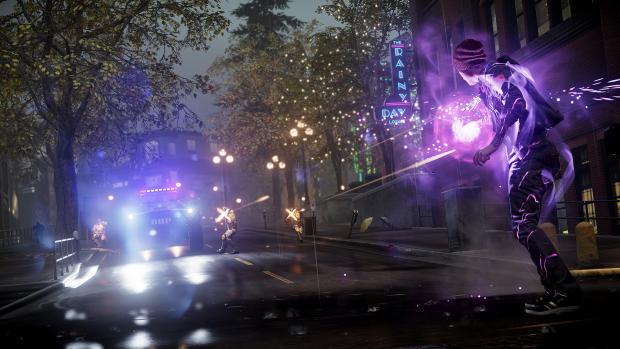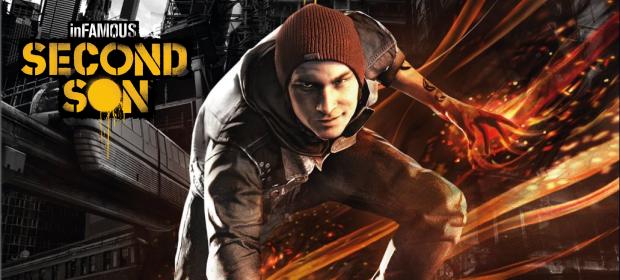While the first two games were thoroughly enjoyable affairs, it’s strange to think that Sony value Infamous so highly as a franchise that they’ve made it the first high profile PlayStation 4 release of 2014. Sucker Punch are certainly a developer with pedigree, but Second Son is very much an example of “if it ain’t broke, don’t fix it” design, albeit with a major application of next-gen sheen.
Set seven years after the events of Infamous 2, Second Son introduces Delsin Rowe as our new protagonist – and one that’s a little difficult to like wholeheartedly. Making good or bad choices is a little tricky when Delsin himself appears to be full of youthful pomp, and would rather do his own thing than actually listen to any kind of authority figure, be it his level-headed brother or otherwise. Troy Baker does a fantastic job in terms of the voice acting, it’s just a shame his character is a little hard to identify with.
His quest is noble, at least: a happy-go-lucky Banksy-like stencil artist (and the game starts in the most bizarre way, with a motion controlled spray-painting exercise that is repeated as a regular side quest) is brought into the world of the bio-terrorists (conduits, to nice people) by accidentally gaining the power of Smoke. Enter stage left the bad lady (from the DUP, or Department of Unified Protection) who imprisons all suspected bio-terrorists and tortures them, who thinks Delsin is hiding something, and impales all of his friends and family with concrete (that’s her super-power). Awakening some time later, he sets out on a course to steal her power, as the only way to remove the concrete from these kind souls is by using the same power that put it there in the first place.

Rather smartly, this time around Sucker Punch don’t pretend to make the moral choices anything other than decisions in a video game that influence your powers and social status. Pick the blue path to travel down the heroic route or the red one to become evil, and you’re told this in straightforward wording. While it may make you feel like choices have less impact on the world, at least they aren’t making out that they’re anything other than two binary decisions that decide which set of powers you have at your disposal. As such, the story isn’t deep, though it does have a few touching moments.
Switching out Cole MacGrath’s lightning based powers for a set of smoke ones doesn’t actually feel like a major change if you’ve played prior instalments. Your base attacks are still very similar: you can hold the trigger to aim and fire “bullets” at the enemies, or you can throw a grenade with another button. Rather than absorbing electricity from cards and street lights, you drain smoke from burning cars, or from rooftop ventilation units. It all feels incredibly familiar, and pretty quickly you’ll be holding a button to hover from building to building, just as Cole did.
But you won’t just be playing with Smoke, and pretty quickly you’ll unlock other sets of powers, all of which are visually stunning to play with. Although the move-sets they come with are all pretty similar, they do get better with each new unlock. Switching between the powers at your command isn’t as simple as flicking the D-Pad in a direction, though; instead, you have to absorb whichever source powers the ability. For example, you may be using the second power, Neon, and to get back to using Smoke, you need to absorb it from the relevant source. This does mean that you can’t instantly change between them, but the city layout is clever, and you’re never far from being able to absorb whichever power you want to play with.

Aside from the motion-controlled tagging, the DualShock 4’s speaker is utilised to convey Delsin’s phone ringing, or the noise of absorption from the relevant source. The controls are tight for the most part, and you can aim without moving now, which is very useful, especially given how many enemies you’ll face at any given time – though an unlockable time-slowing zoom makes things easier. There are some touch-pad controlled interactions, too, but they are simply a case of swiping in a direction to open a door, or similar.
Blast Shards make a return as the collectible used to unlock and power up via the skill tree, and are displayed on the map from the start. Some of them are inside moving drones which go on a set pattern, so you’ll have to shoot them down to absorb them. Others are collected by destroying DUP stations, but they are almost always rewards for exploration, which is something Sucker Punch’s version of Seattle does very well. Side quests are varied (though not massively) and mostly revolve around taking back control from the bad guys, before ending in a stand-off to fully remove them from a sector.
Unfortunately, the way that the enemies spam you from all angles also returns for Second Son, meaning there are moments of extreme frustration mixed in with all the fun. Even on normal difficulty, if you’ve not taken the time to reduce the DUP presence significantly, you’re going to struggle. Boss encounters (usually right before you get a new power) are also fairly frustrating affairs until you pass the mid-game mark (the final few bosses are strangely easy), though the reward is always worth it. In fact, most of the best moments of Second Son are when you just explore Seattle and look for side-missions, whether it’s a simple case of tagging a wall with a humorous bit of stencil-art, or you’re tracking a camouflaged DUP agent before chasing him down. Most of the longevity presents itself via optional quests, too, as the main story can be completed comfortably within ten hours – though there’s the obvious choice to replay the game with the opposite karmic choices and powers.

It hits you straight away that Second Son is absolutely gorgeous, and it’s exactly what you want to see on a console you’ve recently shelled out a large wedge of cash for. Seriously, this is one of the best looking games you’ve ever seen, and it’s technically without hitch throughout. Seattle is rendered here in such a classy manner that it’ll make you want to visit the Emerald City just to see it for yourself. As the rain pours down from the night sky you really do feel like you are playing a game in the next-generation, but it also looks splendid during the day, too. It’s more than just the city though, and there’s some superb lip-syncing going on in Second Son, all helping to create a feeling of believability – perhaps more so than most games that involve super powers and traversing huge buildings.
Matching the visuals is a well-crafted soundtrack that kicks in when needed, but also lets the city’s personality breath. People exist here, and will walk around and react accordingly to your status. Unfortunately there are also cameras dotted around that will set alarms off and bring DUP agents in to assault you. This happens a little too often, and does interrupt your exploration of the city – though not so often as to truly irritate. You might be just jumping from rooftop to rooftop, only to be rudely attacked from the ground, but it’s your decision to fight or run, which is part of the fun.

VERDICT: The city is the true star of Second Son, and for that alone it is worth playing. However, you need to go in knowing that this is a refinement of the series, and not a revolution in terms of gameplay. The fact that Delsin can absorb other people’s powers means that you’re always getting new toys to play with, and Sucker Punch smartly avoid trying to be ultra serious.
Infamous proves that if you look good, sometimes you can get away with things other’s cannot. It’s not the best game in the world, and it’ll frustrate you at times, but the visual splendour is such that you need to see it for yourself to believe it.

GOOD. A game that scores 7/10 is worthy of note, but unworthy of fanfare. It does many things well, but only a few of them incredibly well and, despite a handful of good qualities, fresh ideas and solid mechanics, it fails to overwhelm.
Review code provided by publisher.






